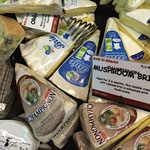
Biofilms—multispecies communities of microbes that live in and on us, and in the environment—are important for human health and the function of ecosystems. But studying these microbial metropolises can be challenging because many of the environments where they’re found are hard to replicate in the lab.
Enter cheese rinds. These biofilms of bacteria and fungi form on the surface of traditionally aged cheeses, and could serve as a system for understanding how microbial communities form and function. By sequencing DNA from the rinds of 137 artisan cheese varieties collected in 10 countries, Rachel Dutton and her colleagues at Harvard University identified three general types of microbial communities that live on their tasty study subjects. After individually culturing representatives of all the species found in the rind communities the scientists added them to a growth medium that included cheese curd. This approach allowed them to recreate the communities in the lab and use them to detect numerous bacterial-fungal interactions and patterns of community composition over time.
The scientists plan to use their lab-grown cheese rinds to study whether and how various microbes compete or cooperate as they form communities, as well as what molecules and mechanisms are involved. In addition to answering fundamental questions about microbial ecology, this cheesy research might ultimately yield insights that help fight infection-causing biofilms or lead to the discovery of new antibiotics.
Learn more:
Harvard University News Release ![]()
Dutton Lab ![]()

